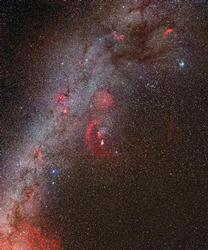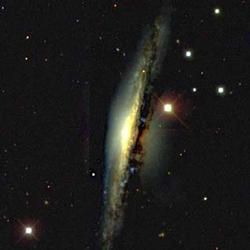Galaxies
Home of Stars
The classification of galaxies due to Hubble (1925) remains the most popular in use today. There are two main categories, the spiral and elliptical galaxies, but also lenticulars and irregulars.
Spirals
like our own galaxy, fall into several classes depending on their shape and the relative size of the bulge: ordinary spirals are labelled either Sa-d,m while those which have developed a bar in the interior region of the spiral arms are SBa-d,m. Spiral galaxies are characterized by the presence of gas in the disk which means star formation remains active at the present time, hence the younger population of stars. Spirals are usually found in the low density galactic field where their delicate shape can avoid disruption by tidal forces from neighbouring galaxies.
From their appearance, galaxies are classified in types as given above, as spiral, lenticular, elliptical, and irregular galaxies, where spirals may be further classified for the presence of a bar (S: spirals, SAB: Intermediate, SB: Barred spirals). More precisely, ellipticals are sub-classified for ellipticity from E7 (strongly elongated) to E0 (circular), and spirals for prominence of bulge versus spiral arms from Sa (or SABa, SBa) to Sc or Sd. This so-called Hubble Classification Scheme can well be illustrated by Messier's galaxies:
- Hubble Scheme with Messier galaxies for HTML browser supporting tables (e.g., Netscape, IBM Webexplorer)
- Hubble Scheme for HTML browsers not supporting tables (Lynx, Mosaic)
The most massive galaxies are giants which are a million times more massive than the lightest: Their mass range is from at most some million times that of our Sun in case of the smallest dwarfs, to several trillion solar masses in case of giants like M87 or M77. Accordingly, the number of stars in them varies in the same range.
The linear size of galaxies also scatters, ranging from small dwarfs of few thousands of light years diameter (like M32) to respectable several 100,000 light years. Among the biggest Messier galaxies are the Andromeda galaxy M31 and the bright active Seyfert II galaxy M77.
Our Milky Way Galaxy, a spiral galaxy, is among the massive and big galaxies with at least 250 billion solar masses (there are hints that the total mass may even be as large as 750 billion to 1 trillion times that of the Sun) and a disk diameter of 100,000 light years.
Besides very many individual stars, most galaxies contain the following typical objects:
- Globular star clusters, large but quite compact agglomerations of some 100,000 to several million stars. These large clusters have about the same mass as the smallest galaxies, and are among the oldest objects in galaxies. Often, they form conspicuous systems, and occur at galaxies of every type and size. The globular cluster systems vary in a wide range in richness between the individual galaxies.
- As the stars develop, many of them leave nebulous remnants (planetary nebulae or supernova remnants) which then populate the galaxies.
- While the older stars, including the globular clusters, tend to form an ellipsoidal bulge, the interstellar gas and dust tends to accumulate in clouds near an equatorial disk, which is often conspicuous (i.e., in spiral and lenticular galaxies).
- The interstellar clouds are the places of star formation. More acurately, huge diffuse nebulae are places where crowded (open) clusters and associations of stars are formed.
- A rather dense galactic nucleus, which is somewhat similar to a "superlarge" globular cluster. In many cases, galactic nuclei contain supermassive dark objects, which are often considered as Black Hole candidates.
Some galactic nuclei are remarkably distinguished from the average: These so-called Active Galactic Nuclei (AGNs) are intensive sources of light of all wavelengths from radio to X-rays. The activities seen in the AGNs are caused by gaseous matter falling into, and interacting with, the supermassive central objects mentioned above, according to the current consensus of most researchers. Sometimes, the spectra of these nuclei indicate enormous gaseous masses in rapid motion; galaxies with such a nucleus are called Seyfert galaxies (for their discoverer, Karl Seyfert). M77 is the brightest Seyfert galaxy in the sky. Few galaxies have even more exotic nuclei, which are extremely compact and extremely bright, outshining their whole parent galaxy; these are called quasars (an acronym for QUAsi-StellAR objects). From their properties, quasars resemble extremely active Seyfert galaxy nuclei. However, quasars are so rare and the nearest is so remote that the brightest of them, 3C273, about 2 billion lightyears away in the constellation Virgo, is only of magnitude 13.7, and none of them is in Messier's or even in the NGC or IC catalog.
Occasionally, at irregular intervals given by chance, in any type of galaxies, a supernova occurs: This is a star suddenly brightning to a high luminosity which may well outshine the whole galaxy; the maximal absolute magnitude of a supernova may well reach -19 to -20 magnitudes. This remarkable phenomenon has attracted the attention of many astronomers (equally both professionals and amateurs), who observe galaxies regularly as they "hunt" supernovae. Supernovae have been observed in several Messier catalog galaxies.
According to our current scientific understanding, at least most galaxies (including our Milky Way and those in Messier's catalog) have formed during a comparatively short period, at about the same time, within the first billion years after the universe started to expand, from an initial hot state. Thus they are all almost as old as the universe itself, currently thought to be about 10-15 billion years. It is thought that galaxy formation started when primordial clouds of gaseous matter (hydrogene and helium), the proto-galaxies, were singled out and started to collapse by their own gravity. According to computer simulations, the variety of galaxy forms results from different initial parameters of the proto-galaxies such as the amount of (initial) angular momentum, as well as their later evolution in their environments, such as interaction with other neighboring galaxies.



